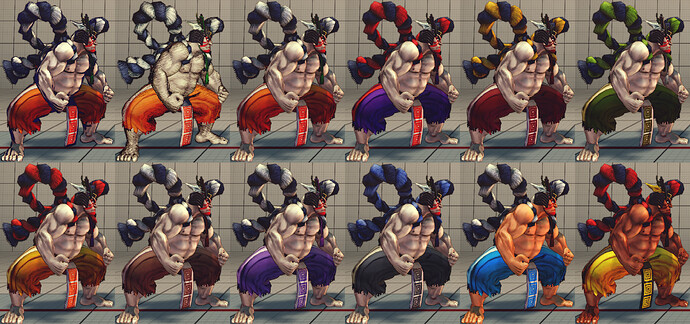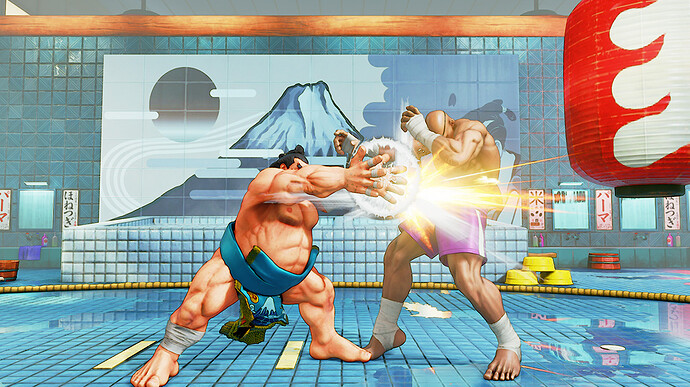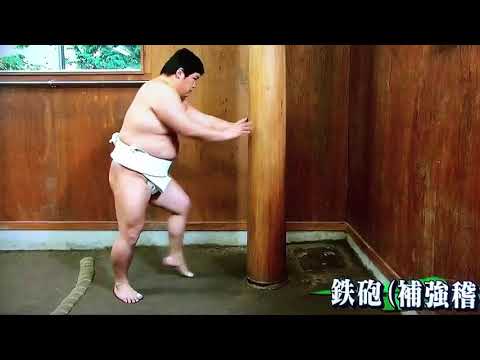SF II-V Bison, please
Poison has become Street Fighter’s Harley Quinn?
What does this mean?
Alpha Bison was SO needed
Will never touch any other Bison alt as soon i unlock it
I may be wrong but iirc FC alts never come with easter egg version
I think Zangief’s came with special win quotes.
I also hope they go back and retroactively change his appearances in SF5 flashbacks and in the Alpha arcade mode to this costume. This is why I am so in favor of an ASF: Director’s Cut - so much can be improved with all the content released since 2016.
That’s because Kinryūzan is based upon the great retired yokozuna Kōji Takanohana, widely known in Japan for his dressing style involving long and showy scarves. There’s even a detailed article on the net (Japanese, sorry) that analyses the brands of his various scarves. Honda himself is partly based upon Takanohana, before Kinryūzan even existed; other real-life inspirations were Akebono (for the double nationality) and others (see below). Some of Kōji Takanohana’s gaudy scarves found on the net:

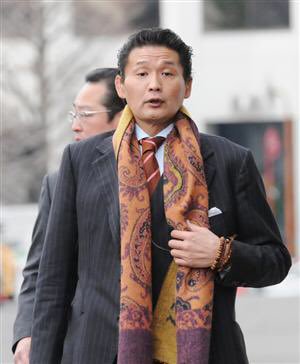
As you all can see, he doesn’t seem like a sumō wrestler at all; even though he lost weight since his retirement, he was considered “slim” even during his career, and a true sex symbol in Japan.
That’s a 睨み nirami , “glare”, a noted feature of kabuki theatre that happens during a 見得 mie . A mie is a dramatic pose struck by the actor (more often the protagonist, but ensemble mies are also common) after an intense action sequence, like a freezing-time frame that highlights the tension of the moment, usually initiated with a rotation of the head that ends in a snap towards the crowd (think of Honda’s victory pose in SF2). During the pose, the actor often glares with his eyes crossed, as this article brilliantly explains.
Incidentally, Honda’s face wears 隈取り kumadori , the traditional kabuki makeup mainly reserved for the 荒事 aragoto (“rough matters”, meaning the action pieces).
The specific character Capcom based Honda’s kumadori upon is Kamakura Gongorō Kagemasa, from the play 暫 Shibaraku (“Just a moment”), THE stereotypical hero of kabuki theatre. The role is traditionally given to actors of the Ichikawa family, all bearing the stage name Ichikawa Danjūrō. At present, there’s no Ichikawa Danjūrō, as the twelfth one died in 2013 and his son is set to take the name Ichikawa Danjūrō XIII in May 2020. The Ichikawa family crest is the 三升 sanshō (“three squares”), three squares one inside another, often featured in Gongorō’s costume:
Capcom finally acknowledged the inspiration in SFIV with Honda’s third alternate costume: although simplified for better movement, it’s even clearly visible the family crest of the Ichikawas:
Obviously, Honda’s “hold it right there!” comes straight from Shibaraku, because Gongorō repeatedly shouts that exact word from the backstage (Shibaraku! Shibaraku! Shibaraaaaku!) to make his bombastic entry on stage. However, and less obviously, the original Japanese version of “hold it right there”, is いや、待たれい iya, matarei! and not 暫 shibaraku. That’s another stereotypical way of saying “hold it”, coming from samurai lingo. Since it appears in kabuki as well, the two are frequently confused, but shibaraku is SO automatically reminiscent of its eponimous play that I think Capcom didn’t want to associate Honda too closely with a single specific kabuki play and preferred to keep him generic.
The dance on one foot Honda makes at the end of the match is a 飛び六方 tobiroppō , “six directions flying” (because its preparation requires to move the arms in six directions), the stereotypical exit from stage that a kabuki actor makes at the end of an intense action play (the most famous one being performed in the play Kanjinchō ), bouncing on one foot with the other leg lifted and bent, while pushing the hand downwards. It’s already known in the FGC because of Samurai Spirit’s Kyōshirō Senryō (his regular STANDING POSE) and Ganryū (his old infinite “kabuki harite”, down + RP, RP, RP…), although originally a kabuki actor alternates sides every few steps when performing it - while Ganryū remains on the same foot. Honda correctly alternates sides. He already struck that pose for a brief moment during his second Ultra in SFIV, at the apex of his jump, complete with a 掛け声 kakegoe, a kabuki shouting in the background (“IYOOO…”), on top of it. Demonstrated here:
See Honda’s second Ultra in SFIV:
VSkill
猫騙し NEKODAMASHI “Cat fooling” is an unorthodox and rare sumō strategy, not a real move, involving a sudden clap in front of the face of one’s opponent, in order to make him instinctively close his eyes. If you think that’s a childish tactics and could never work, then yokozuna Hakuhō is ready to prove you wrong:
Jump to 2’44’’ and you can see how this completely catches his opponent by surprise during his charge, leaving him open to an easy counterattack. Hakuhō’s smirk after his victory is priceless, haha.
Honda’s neko damashi can cancel projectiles and remove guard. Interesting. Also interesting that, as rare as this “move” is, it was included in the movesets of VF’s Taka Arashi and Tekken’s Ganryū.
VReversal
雷電砲 Raidenhō , “Raiden cannon”. Although it can remind anyone on the FGC of the Japanese thunder god Raiden, it actually references Raiden Tameemon (1767-1825), considered by many Japanese the strongest sumō wrestler in history. With a winning record of 254-10 and a winning percentage of 96.2, he dominated sumō in his era, although he was always ōzeki and never promoted to yokozuna; and that’s another trait Honda shares with him… maybe not anymore? Capcom didn’t clarify whether Honda was promoted or not, although his first alternate costume in SFIV sported an ornated belt that only a yokozuna can wear. He was addressed as “without peer in the world”, aka 天下無双 tenka musō (yeah, Honda’s Onimusō…). He was so strong that, in order to keep his matches interesting, sumō authorities often forbid him to use his favourite moves, among which there was the 鉄砲 teppō (“arquebus”, literally “iron cannon”), a palm strike to the torso. It’s a part of basic sumō training, where the wrestler alternately strikes with the palm of the hands a wooden (or iron) pillar, demonstrated here:
Vtrigger I
鬼瓦 ONIGAWARA “ogre roof tile” is an architectural ornament on the roofs of Japanese traditional houses, a tile with an oni face to ward off evil spirits. Onigawara also means a scary face because of its angry glare.
During Onigawara’s activation, and even during his CA, Honda executes a ritual sumō 塵手水 chirichōzu, “washing out impurities”, a movement composed of a squat with knees spread out to the sides, a brief washing motion of the hands that subsequently clap, then a raising of both arms extended, in order to show the opponent that the wrestler is unarmed and ready to fight fair. Shown here in slow motion by veteran wrestler Takaya Kotofuji:
VTrigger I allows the use of the new move 鬼大角 Oni daikaku , “Ogre Big Horn”, where “horn” is the old Japanese (and Chinese, still used in 摔角 shuāijiāo , “throwing and butting”) name of wrestling itself because it was originally a clash with headbutts, like a “battle of horns”. A relic of this past can still be seen in the initial charge of sumō wrestlers against one another.
VTrigger II
手力男 TAJIKARAO (full name 天手力男 Ame no Tajikarao , “The man with strong arms from the Heaven”) is the Japanese god of strength, and he was the one who pulled the Sun Goddess Amaterasu out from the Iwato cave, in which she was hiding, thus returning the sunlight to the world. Honda strikes another kabuki mie during the activation.
During this VTrigger, Honda can use the new wall-bouncing throw we see in the trailer, 岩戸開き Iwato Biraki , “Rock cave opener”; again referencing the myth about Tajikarao grabbing the boulder that closed the entrance of the Iwato cave and tossing it away, before taking hold of Amaterasu and forcing her out.
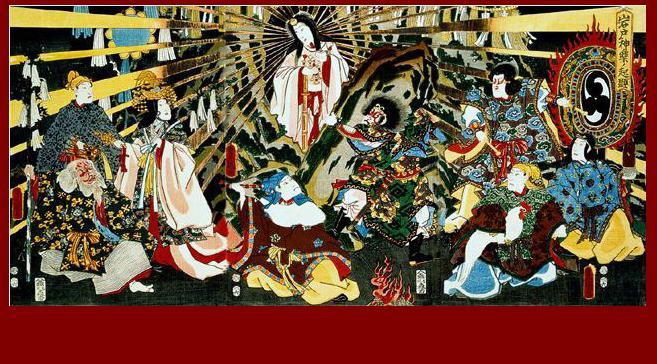
CA
神ヶ島 KAMIGASHIMA “Island of the Gods” is… Well, Japan. And a gunbow in Monster Hunter, LOL. But the truly hilarious part here is Honda shouting これが神ヶ島だあぁ Kore ga Kamigashima daaa!, “this is Kamigashimaaa”… Basically the Japanese version of “this is Spartaaa” ![]()


Here, ゆ yu “hot water” is the classic writing out of every public bath in Japan.
勝負あり Shōbu ari , “Victory”, directly from SF2. Note the cross-eyed glare… Incidentally, the face depicted here strongly resembles the famous 1794 portrait of kabuki actor Ōtani Oniji III in the Role of the Servant Edobei , by famed ukiyoe artist Tōshūsai Sharaku:
Although the expression is nearly identical, this interview reveals that the actual model was Akira Nishitani himself.

加富根湯 Kapukon’yu , aka “CAPCOM’s public bath”.

Various sponsors:
米 kome “rice” and under it こめや komeya , a rice vendor;
パーマ pāma , “perm”, an hairdressing salon;
ほねつぎ honetsugi , a traditional chiropractor and bonesetter ;
ほん hon , “books”, a bookshop.
Of further interest is that Honda… hasn’t a single real sumō throw in his arsenal. The closest ones are Iwato Biraki (in real sumō a 寄り切り yorikiri, a frontal force out of the ring) and 俵投げ tawara nage (“rice bale throw”. Rice bales are half-buried in the sumo ring to mark its boundaries), in real sumō a 掬い投げ sukui nage, “scoop throw”, the sumō equivalent of pro-wrestling hip toss.
鯖折り Sabaori “Mackerel breaker” IS the name of a real sumō move, but it’s not what Honda does (that’s a pro-wrestling bear hug, barred in sumō). The actual sabaori is a rare and dangerous technique consisting in grabbing the opponent’s belt and throwing one’s own weight upon one of the opponent’s legs, forcing it to bend and drop to the knee. In sumō touching the ring with any body part that’s not the sole of the foot is a loss, so sabaori is an instant winning (and injury, if the wrestlers involved are particularly heavy…) move. Demonstrated here, with injury:
The name “sabaori” comes from the old practice of breaking the neck of mackerels in order to keep them fresh, because before the invention of refrigeration mackerels were fishes susceptible to rot very quickly, and breaking their neck causes a severe blood drain that keeps them fresh (if you want to see it, here is a demonstration. NOT for animal lovers or otherwise sensitive persons). The bent knee figure of a wrestler resembled a mackerel with a broken neck, hence the name of the move. I didn’t know why Capcom assigned that name to a bear hug and spread the misconception that’s a move common in sumō, until I found the source; my three theories were that they confused sabaori with 背骨折り seboneori “backbreaker”… Or simply that back in the sprites era they didn’t have enough choice. Lastly, it was possible they wanted to pay homage to the 1988 movie Bloodsport, in which a character named Pumola - who strongly resembles a sumō wrestler - regularly finishes his matches using a bear hug (yes, the guy Van Damme beats with the nut punch later homaged by MK’s Johnny Cage). It turned out that they wanted to reference a MANGA instead. I’ll speak about it in due time.
大銀杏投げ Ōichō nage “great ginkgo throw”, is another non-existent move (it’s forbidden to hit a floored opponent in sumō). It references the 大銀杏髷 ōichō mage, “great ginkgo top-knot”, a wrestler hairstyle (reserved to fighters of the upper division) that makes hair resemble a ginkgo leaf.
Whats the difference with Aloha bisons costume. Is it just a cape? Or is the suit more baggy.
Just when I thought I couldn’t love the SF2 roster more, you go ahead and post that. Thank you. I hope Honda finds new appreciation with younger people.
Face, hair, hat, cape, shoulder, and leg armor. Trench coat gone, and the pants look baggier. Need to see in motion to confirm.
And you could archive all that lore in a wiki so it won’t get lost and unappreciated ![]()
That’s awesome dude, cool detail
Thanks mate. I meant though between alpha and classic. Is it just the cape and mc hammer pants?
Did they ever do SF2 costumes for Ken and Vega?
For Vega yes, its in fighting chance, no yet for Ken though ![]()
No Sf2 Ken but Sf2 vega is yes
Will be cool of they made him a bit more thick and muscular, SFA Bison was fucking tank
SF2 Ken Is no doubt the most needed right now, even if personally i want even more a true SF2 Ryu
Not going to happen but i will LOVE get SF2 Zangief and Cammy too
SF2 Zangief could have been even just a color lol
Probably because they think Rekkas isnt something beginner friendly for executions so they probably put in a special condition just like Karins.
Still secretly hoping Capcom sneak in an update to SF5’s Ken hair before it is all said and done. ![]()
If Effie was a song
Also Skullomania is on fucking guitars.

